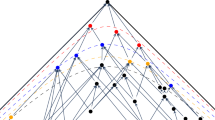Abstract
In this paper we will define a Lagrangian for scalar and gauge fields on causal sets, based on the selection of an Alexandrov set in which the variations of appropriate expressions in terms of either the scalar field or the gauge field holonomies around suitable loops take on the least value. For these fields, we will find that the values of the variations of these expressions define Lagrangians in covariant form.
Similar content being viewed by others
Data Availability
It is available on arXiv:0807.4709. Also, one of the older versions of this was posted on Proceedings for “Workshop on Continuous and Lattice Approaches to Quantum Gravity 17-19 September 2008” However, the Proceeding paper is a lot shorter: it is only 8 pages. So it is abbreviated in a lot of ways. For example, it doesn’t do a lot of the explicit calculations that are being done here. It also focuses exclusively on real scalar field and electromagnetic field, but it doesn’t do complex scalar fields, spin 0 multiplets and non-commutative gauge fields.
Code Availability
I used latex. While I submitted the PDF file, I still have the TeX version of it at the computer at home.
References
Wüthrich, C., Huggett, Nick: Out of Nowhere: Spacetime from causality: causal set theory. arXiv:http://arxiv.org/abs/2005.10873
Surya, S.: Causal set approach to quantum gravity. Living Rev. Relativ. 22(5). arXiv:http://arxiv.org/abs/1903.11544 (2019)
Hawking, S.W., King, A.R., McCarthy, P.J.: A new topology for curved spacetime which incorporates the causal, differential and conformal structures. J. Math. Phys. 17, 174–181 (1976)
Malament, D.: The class of continuous timelike curves determines the topology of spacetime. J. Math. Phys. 18, 1399–1404 (1977)
Gibbons, G.W., Solodukhin, S.N.: The geometry of small causal diamonds. Phys. Lett. B649, 317–324 (2007). arXiv:http://arxiv.org/abs/hep-th/0703098
Brightwell, G., Gregory, R.: Structure of random discrete spacetime. Phys. Rev Lett. 66, 260–263 (1991)
Ilie, R., Thompson, G.B., Reid, D.D.: A numerical study of the correspondence between paths in a causal set and geodesics in the continuum. Class. Quantum Grav. 23, 3275 (2006). arXiv:http://arxiv.org/abs/gr-qc/0512073
Dowker, F., Glaser, L.: Causal set d’Alembertians for various dimensions. Class. Quantum Grav. 30, 195016 (2013). arXiv:http://arxiv.org/abs/1305.2588
Aslanbeigi, S., Saravani, M., Sorkin, R.D.: Generalized causal set d’alembertians. https://doi.org/10.1007/JHEP06(2014)024arXiv:http://arxiv.org/abs/1403.1622
Carlip, S.: Dimension and dimensional reduction in quantum gravity. arXiv:http://arxiv.org/abs/1904.04379
Cooperman, J.H., Dorghabekov, M.: arXiv:http://arxiv.org/abs/1812.09331. Phys. Rev. D 100, 026014 (2019)
Sverdlov, R., Bombelli, L.: Gravity and matter in causal set theory. arXiv:http://arxiv.org/abs/0801.0240v2 (2008)
Sverdlov, R: Gauge fields in causal set theory. arXiv:http://arxiv.org/abs/0807.2066(2008)
Sverdlov, R: Electromagnetic Lagrangian on a causal set that resides on edges rather than points. arXiv:http://arxiv.org/abs/1805.08064
Sorkin, D.P.: Does locality fail at intermediate length-scales. arXiv:http://arxiv.org/abs/gr-qc/0703099 (2007)
Sverdlov, R.: Non-linear corrections to Lagrangians predicted by causal set theory: Flat space bosonic toy model. arXiv:http://arxiv.org/abs/1201.5850
Kamalov, T.F.: Quantum correction for Newton’s law of motion. Symmetry 12, 63 (2020)
Kambor, J., Nomaan, X.: Manifold properties from causal sets using chains. arXiv:http://arxiv.org/abs/2007.03835
Gleason, J.: Existence and uniqueness of Haar measure. https://meduza.io/feature/2018/09/22/kazhdaya-storona-osoznaet-sebya-zhertvoy-eto-sostoyanie-blizkoe-k-paranoye
Boya, L.J., Sudarshan, E.C.G., Tilma, T.: Volumes of compact manifolds. https:math-ph/0210033.pdf
Rideout, D.P., Sorkin, R.D.: A classical sequential growth dynamics for causal sets. Phys. Rev. D61, 024002 (2000). arXiv:http://arxiv.org/abs/gr-qc/9904062
Robb, A.A.: The Absolute Relations of Time and Space. Cambridge U. P., Cambridge (1921). 80p
Robb, A.A.: Geometry of Time and Space. Cambridge University, Cambridge (1936)
Sverdlov, R.: Gauge fields in causal set theory. arXiv:http://arxiv.org/abs/0807.2066
Sverdlov, R.: Electromagnetic Lagrangian on a causal set that resides on edges rather than points. arXiv:http://arxiv.org/abs/1805.08064
Sverdlov, R.: Continuous measurement on a causal set with and without a boundary. arXiv:http://arxiv.org/abs/2006.08724
Sverdlov, R.: Causal set as a discretized phase spacetime. arXiv:http://arxiv.org/abs/0910.2498
Sverdlov, R.: Quantum field theory on a causal set. PoS LATTICE2018. 234 (2019)
Aghili, M.: Manifoldlike causal sets. Ph.D. Thesis, University of Mississippi. https://egrove.olemiss.edu/etd/1529/
Rideout, D.: Dynamics of causal sets. Ph.D. Thesis https://cds.cern.ch/record/597403/files/0212064.pdf
Sorkin, R.D.: Causal sets: discrete gravity. https://cds.cern.ch/record/640720/files/0309009.pdf
Funding
I am currently a graduate student at the University of New Mexico and, as such, I am a Teaching Assistant, so I get paid for teaching.
Author information
Authors and Affiliations
Contributions
The current paper is single author, although the Proceeding (cited above) was joint work with Luca Bombelli.
Corresponding author
Ethics declarations
Conflict of Interests
While the current paper is single author, the Proceeding (cited below) was joint work with Luca Bombelli. However, seeing that the Proceedings below is a lot shorter than the current paper, and the presentation is different, I regard it as a separate paper, so I don’t see any conflict of interest.
Additional information
Publisher’s Note
Springer Nature remains neutral with regard to jurisdictional claims in published maps and institutional affiliations.
Rights and permissions
About this article
Cite this article
Sverdlov, R. Bosonic Fields in Causal Set Theory. Int J Theor Phys 60, 1481–1506 (2021). https://doi.org/10.1007/s10773-021-04772-6
Received:
Accepted:
Published:
Issue Date:
DOI: https://doi.org/10.1007/s10773-021-04772-6




